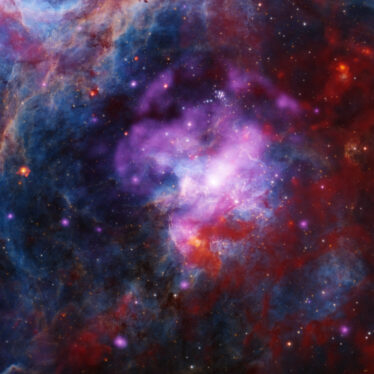
A colorful, festive image shows different types of light containing the remains of not one, but at least two, exploded stars. This supernova remnant is known as 30 Doradus B (30 Dor B for short) and is part of a larger region of space where stars have been continuously forming for the past 8 to 10 million years. It is a complex landscape of dark clouds of gas, young stars, high-energy shocks, and superheated gas, located 160,000 light-years away from Earth in the Large Magellanic Cloud, a small satellite galaxy of the Milky Way.
The new image of 30 Dor B was made by combining X-ray data from NASA’s Chandra X-ray Observatory (purple), optical data from the Blanco 4-meter telescope in Chile (orange and cyan), and infrared data from NASA’s Spitzer Space Telescope (red). Optical data from NASA’s Hubble Space Telescope was also added in black and white to highlight sharp features in the image.
A team of astronomers led by Wei-An Chen from the National Taiwan University in Taipei, Taiwan, have used over two million seconds of Chandra observing time of 30 Dor B and its surroundings to analyze the region. They found a faint shell of X-rays that extends about 130 light-years across. (For context, the nearest star to the Sun is about 4 light-years away). The Chandra data also reveals that 30 Dor B contains winds of particles blowing away from a pulsar, creating what is known as a pulsar wind nebula.
When taken together with data from Hubble and other telescopes, the researchers determined that no single supernova explosion could explain what is being seen. Both the pulsar and the bright X-rays seen in the center of 30 Dor B likely resulted from a supernova explosion after the collapse of a massive star about 5,000 years ago. The larger, faint shell of X-rays, however, is too big to have resulted from the same supernova. Instead, the team thinks that at least two supernova explosions took place in 30 Dor B, with the X-ray shell produced by another supernova more than 5,000 years ago. It is also quite possible that even more happened in the past.
This result can help astronomers learn more about the lives of massive stars, and the effects of their supernova explosions.
The paper led by Wei-An Chen describing these results was recently published in the Astronomical Journal. The co-authors of the paper are Chuan-Jui Li, You-Hua Chu, Shutaro Ueda, Kuo-Song Wang, Sheng-Yuan Liu, all from the Institute of Astronomy and Astrophysics, Academia Sinica, in Taipei, Taiwan, and Bo-An Chen from National Taiwan University.
NASA’s Marshall Space Flight Center manages the Chandra program. The Smithsonian Astrophysical Observatory’s Chandra X-ray Center controls science operations from Cambridge, Massachusetts, and flight operations from Burlington, Massachusetts.
Read more from NASA’s Chandra X-ray Observatory.
For more Chandra images, multimedia and related materials, visit:
https://www.nasa.gov/mission/chandra-x-ray-observatory/
Visual Description:
Today’s release features a spectacular composite image of a large region of space where stars have been continuously forming for the past eight to ten million years. At the center of this complex landscape of brilliant, colorful gas clouds is a supernova remnant. Known as 30 Doradus B, the remnant likely contains the remains of at least two exploded stars.
The entire image is awash in intricate clouds, and swathes of superheated gas. At our upper lefthand corner is a thick, coral pink and wine-colored cloud with a texture resembling cotton candy. At our lower and upper right is a network of deep red clouds that resemble streaks of thick red syrup floating in water. A layer of wispy blue cloud appears to be present across the entire image, but is most evident at our lower left which is free of overlapping gas. Glowing pink, orange, and purple specks of light, which are stars, dot the image.
In the center of the frame is a bright purple and pink cloud, aglow with brilliant white dots, and streaked with lightning-like veins. This is 30 Doradus B, which is delineated by a faint shell of X-rays identified by Chandra. Within this supernova remnant are high energy shocks and winds of particles blowing away from a pulsar.
News Media Contact
Megan Watzke
Chandra X-ray Center
Cambridge, Mass.
617-496-7998
Jonathan Deal
Marshall Space Flight Center
Huntsville, Ala.
256-544-0034
https://www.nasa.gov/image-article/nasa-telescopes-start-the-year-with-a-double-bang/





